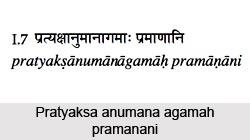 Correct knowledge is direct, inferred or proven as factual - this what has been ideally described in this seventh yoga sutra, pratyaksa anumana agamah pramanani.
Correct knowledge is direct, inferred or proven as factual - this what has been ideally described in this seventh yoga sutra, pratyaksa anumana agamah pramanani.
pratyaksa direct perception
anumana inference
agamah traditional sacred texts or scriptural references, a person who is a scriptural authority and whose word can be relied on
pramanani kinds of proof
Correct knowledge is direct, inferred or proven as factual.
Correct knowledge is based on three kinds of evidence - direct perception, correct inference or deduction, and testimony from authoritative sacred scriptures or experienced persons.
Initially, individual perception should be ascertained by rational logic, and then checked to correspond to traditional or scriptural wisdom. This process necessitates the enlightened intelligence, or buddhi.
In present intellectual terms, buddhi is regarded as a monolithic entity. This is discouraging when attempting to understand its true role in human life and in everyday yogic practice. It is mandatory to first separate it from mind, where brain, whose function is to receive sensory information, to think and to act, has its source taking expresses itself in the form of electro-magnetic waves.
Intellect is subtler than mind. It is concerned with the knowledge of acts and the analysing ability, and becomes noticeable only through its monolithic quality, intelligence, which is closer to consciousness rather than to the mind or thought process. Intelligence is innate in every aspect of human existence, from the physical to the blissful. It is non-manifest only in the atmanJpurusa, the core of being.
The quality of intelligence is inherent but inactive, so one`s primary step must be to awaken it. The practice of asana brings intelligence to the surface of the cellular body through stretching and to the physiological body by holding the pose. Once aroused, intelligence can unwrap its vibrant aspect, its ability to tell apart. Then one endeavours for equal extensions to achieve a balanced, unwavering posture, measuring the upper arm stretch against lower, right leg against left, inner against outer, etc. This precise, thorough process of measuring and discriminating is the apprenticeship, or culturing of intelligence; it is followed in the internal sheaths by pranayama, pratyahara and the advanced stages of yoga.
It can thus be seen that discrimination is a pressing process, belonging to the world of duality. When what is wrong is discarded, what is left should be correct.
When discrimination has been cultivated and intelligence is full and dazzling, ego and mind retreats, and dtta becomes astute and clear. But spiritual intelligence, which stands for true wisdom, gets through only when discrimination ends. Wisdom does not function in dichotomy. It recognises only oneness. It does not abandon the wrong, it perceives only the right. (Patanjali calls this exalted intelligence, or vivekajajOanam, m.55.) Wisdom is not unified with nature, and is indeed inappropriate for the difficulties of life in a dualistic world. It would be of no use to a politician, for instance, however high his motives, for he must pick and decide in the relative and impermanent world. Spiritual wisdom does not decide, it knows. It is beyond time.
However, the progressive refinement of intelligence is indispensable for the search for freedom. The incisive intellect should be used to `defuse` the negative impact of memory, which links humankind in psychological time to the world of sensory pleasure and pain.
Every matter, from rocks to human cells, contains its own intrinsic intelligence, but only man has the capability to arouse, culture and finally surpass intelligence. Just as the totally pure citta, free from sensory entrapments, gravitates towards the atman, so, once intelligence has accomplished the highest knowledge of nature, it is attracted inwards towards the soul (iv.26). Buddht has the capacity to comprehend itself - its inherent virtue being honesty (1.49).




















